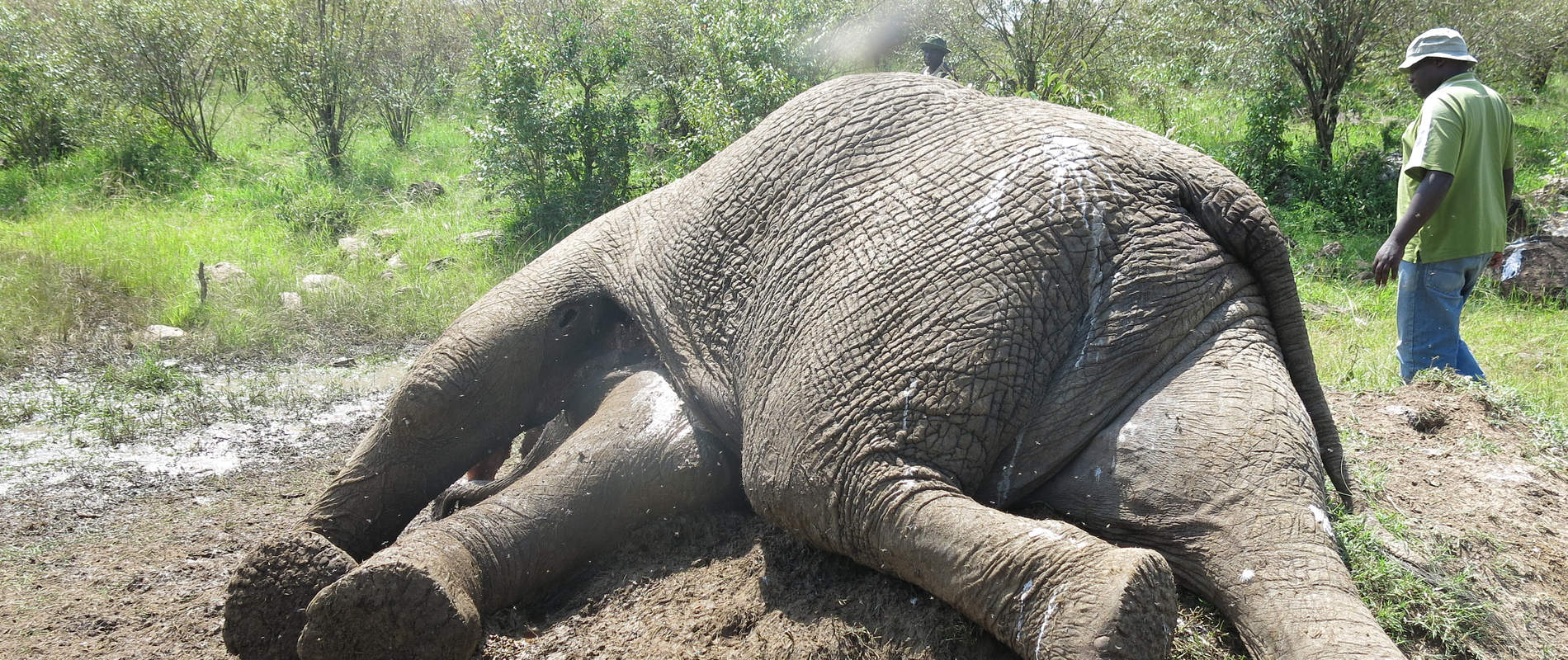FIELD VETERINARY REPORT FOR MASAI MARA–JUNE 2015 By Campaign K
FIELD VETERINARY REPORT FOR MASAI MARA–JUNE 2015
By Campaign K. Limo
Introduction
The conservation area has continued to experience precipitation with this month exhibiting a rise in intensity and distribution. Vegetation is flourishing and most of the wildlife have plenty of forage and are doing well. For the third month running, cases requiring veterinary intervention have decreased. This could be attributed to reduced conflict with locals as a result of resource availability and also decreased wandering of wildlife in search of these resources.
The following are cases attended to during the month under review;
CASE#1 EUTHANASIA OF AN ELEPHANT WITH A BROKEN LEG
Date: 6th June 2015
Species: African elephant
Age: Adult
Sex: Male
Location: Lolgorian, Trans mara
History
This elephant was seen by KWS and Mara Elephant Project security teams on their routine patrols. He was alone in a thicket unable to move far and limping on one of his hind quarters. They requested our services to asses and provide help.
This elephant had retreated deep into the forest and tracking was only possible by foot. He appeared to be in a lot of pain and had an obvious limp of his right hind quarters. He could hardly put any weight on this limb which appeared bruised and swollen. A decision to immobilize this elephant for closer examination was arrived at.
Immobilization, examination and management
Immobilization was achieved by use of 16mgs Etorphine Hydrochloride in a 3ml Dan-inject dart from foot. The drugs took full effect after eight minutes with the elephant assuming left lateral recumbency which therefore made it easy to examine the injured leg. After making sure the elephant was stable, the injured leg was closely examined. This revealed a compound fracture of the distal part of tibia fibula. The skin around the fracture area was broken with broken bone partially visible. The fracture could have occurred three days before examination.
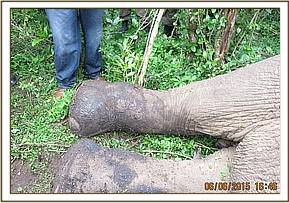
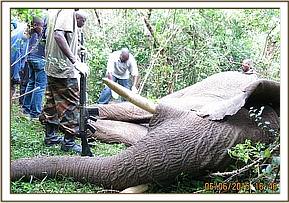
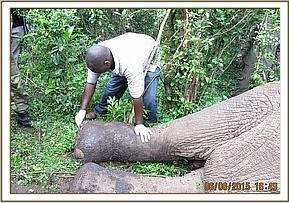

Bearing in mind the age, weight and condition of the fracture of this elephant, chances of healing was considered nil. To save further suffering of this big elephant, euthanasia was advised and promptly effected. The tusks were recovered and taken by KWS security team for accounting and safe custody.
CASE#2 TREATMENT OF AN ELEPHANT WITH AN ARROW WOUND
Date: June 2015
Species: African elephant
Age: Adult
Sex: Male
Location: Olarro conservancy
History
This elephant was seen alone in a thicket within Olarro conservancy limping on one of his front legs. Olarro conservancy management called the mobile veterinary unit for intervention. The elephant was found alone in a thicket inaccessible by vehicle. He appeared to be limping on his front right leg with a swelling of the carpus. His body condition was still good and he was browsing.
Immobilization, examination and treatment
Immobilization was achieved by use of 16mgs Etorphine hydrochloride delivered in a 3ml Daninject dart from foot. It took 12 minutes for the elephant to give in to the anaesthetic, going down on his left lateral side.
Examination revealed a penetrating wound to the caudal surface of his right carpus five inches deep and one inch wide most likely caused by an arrow. The wound was still fresh and joint integrity was not affected. Further probing of the wound yielded nothing as the offending foreign object had fallen out.


The wound was lavaged with copious amount of water and debrided with hydrogen peroxide. Tincture of iodine was then used to disinfect before Oxytetracycline wound spray and green clay were applied. Additional treatments included parenteral administration of 20000mgs Oxytetracycline hydrochloride antibiotic and 160mgs Dexamethasone sodium anti-inflammatory.
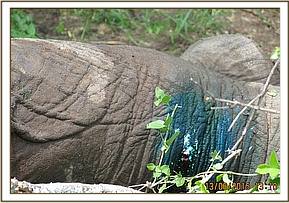

Reversal
Reversal of the anesthetic was achieved by administration of 48mgs Diprenorphine hydrochloride through the superficial ear vein. He woke up after four minutes, stood for a while and retreated deep into the thicket.
Prognosis
Good
CASE#3 INJURED LIONESS IN MARA NORTH CONSERVANCY
Date: June 2015
Species: Lion
Age: Adult
Sex: Female
Location: Mara North Conservancy
History
This lioness was seen by Mara North Conservancy rangers alone, weak and with an injury to her tail. She had two adult cubs, a male and a female who had briefly abandoned her. The Veterinary Unit found this lioness under a tree on lateral recumbency in pain and unwilling to stand even on agitation. The distal three quarters of her tail was becoming gangrenous with coccygeal bones at the injury side visible. She had other visible bite wounds variously distributed.
Immobilization, examination and treatment
After vigorous agitation, the lioness stood up and moved briefly before lying down again. She was restrained with a combination of 200mgs Ketamine and 3mgs Medetomidine delivered in a 3ml Dan-inject dart from a vehicle. She stood and moved for a short distance before giving in to anaesthesia after seven minutes. Eye ointment and a blindfold was put in place before examination which revealed fight wounds probably with members of another pride causing extensive injury to her tail and part of the perineum. Other bite wounds were evident on other parts of her body.
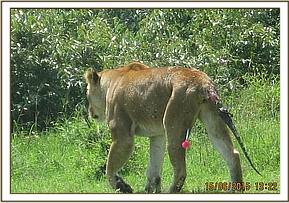

To stop infection and necrosis from ascending a decision to amputate the tail slightly proximal to the injured site was arrived at. This was to facilitate quick healing as this area still had good blood supply. Damaged perineal tissues were debrided refreshed and absorbable sutures put in place. Bleeders on the tail were duly ligated and the resultant wound disinfected with tincture of iodine.Cloxacillin ointment was then liberally applied before Oxytetracycline wound spray being applied topically. All other bite wounds were debrided with Hydrogen peroxide, disinfected with tincture of Iodine before Oxytetracycline spray being applied.
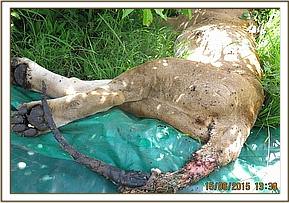

Additional treatments included parenteral administration of 3000mgs Amoxicillin antibiotic, 20mgs Dexamethasone sodium anti-inflammatory and 80mgs Ivermectin parasiticide.
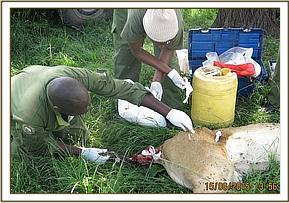

Reversal
Reversal of the anesthetic was achieved by intramuscular administration of 15mgs Atipamizole hydrochloride one hour after immobilization. She woke up after eight minutes, moved slightly and rested under a tree.
Prognosis
Good. It was reported she fed on a kill one day after treatment and appeared to be coping well. She was reunited with her cubs.
CASE#4 POST MORTEM OF A YOUNG ELEPHANT BULL
Date: June 2015
Species: African elephant
Age: Young adult
Sex: Male
Location: Naboisho conservancy
History
This elephant was reported dead on the morning of this date by Naboisho Conservancy Management. This elephant was not seen with any injury or illness prior to this and Management requested our services to determine cause of death.
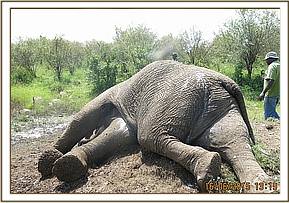
General observation of the carcass
- The elephant died on top of a small hill with both tusks intact. Blood was gushing from his trunk and mouth at the time and soon after death.
- He was in good condition prior to death with body score of 4 in a scale of 1-5 where 1 is poor and 5 perfect.
- No external injury observed elsewhere even after turning the carcass over.
- Nothing abnormal detected on blood smear.
On opening the carcass, the following was noted.
1) The entire thoracic cavity including the lungs was bloody. The lungs were drowning with blood.
2) No other abnormality detected in other organs.
Post mortem diagnosis
Rupture of major pulmonary vessel, resulting in shock and instant death. The tusks were recovered and handed over to KWS security team for custody.
CASE#5 ELEPHANT COLLARING EXERCISE
Date: 22nd June 2015
Species: African elephant
Age: Adult
Sex: Male
Location: Mara Triangle Conservancy
History
Collaring is a wildlife management tool to help inform management on wildlife movements. KWS, Save the Elephant, Mara Elephant Project and Mara Triangle Conservancy agreed to fit a SAT/GSM collar on one bull elephant in Mara Triangle Conservancy. This elephant was identified on the basis of his long range movements and occasional absence from the conservancy.
Immobilization and collaring
This massive bull was immobilized by use of 16mgs Etorphine hydrochloride delivered through a 3ml Daninject dart from a vehicle. It took ten minutes for the drugs to take full effect with the elephant assuming sterna recumbency in a small thicket. After weighing the options, it was decided to collar this elephant but quickly as this position could compromise breathing.
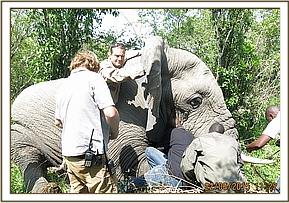

Reversal
The collar was quickly deployed, soundness ascertained before reversing this elephant with 42mgs Diprenorphine hydrochloride through a superficial ear vein. He woke up within two minutes without complications.
CASE#6 DESNARING A ZEBRA
Date: 22nd June 2015
Species: Common zebra
Age: Adult
Sex: Female
Location: Olare Orok Conservancy.
History
Management of Richard’s camp in Olare Orok saw this zebra grazing with others near their camp. She had a snare round her left hind leg. He sought the services of the unit to de-snare this zebra.
This female was found a few meters from the camp grazing with a male companion who was very protective of her. She could hardly place weight on the affected limb with muscles showing symptoms of atrophy due to disuse. She was obviously in a lot of pain.
Immobilization, examination and treatment
This zebra was chemically restrained by use of a combination of 5mgs Etorphine hydrochloride and 50mgs Azaperone delivered in a 3ml Dan-inject dart from a vehicle. The drugs took full effect after seven minutes whereupon eye ointment and a blindfold was applied.
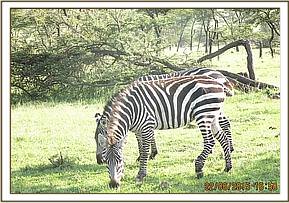

Examination revealed a tight snare at the fetlock joint which had eaten into the surrounding tissues but the joint integrity was sound. The braided wire was cut loose and removed. The resultant wound was cleaned with hydrogen peroxide and water then tincture of iodine was used to disinfect before Oxytetracycline wound spray was applied topically. Additional treatments include parenteral administration of 3000mgs Amoxicillin antibiotic, 16mgs Dexamethasone sodium anti-inflammatory and 80mgs Ivermectin parasiticide.
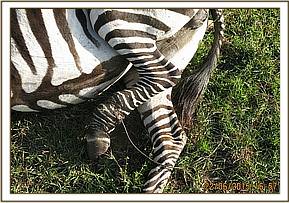

Reversal
Reversal of the anesthetic was achieved by administration of 18mgs Diprenorphine hydrochloride intravenously through the jugular vein. She woke almost immediately and joined her waiting male companion.
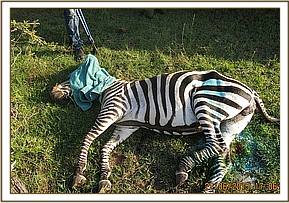

Prognosis.
Good
CASE#7 TREATMENT OF AN ELEPHANT WITH AN ARROW WOUND
Date: 23rd June 2015
Species: African elephant
Age: Adult
Sex: Male
Location: Musiara, Masai Mara Reserve
History
This massive bull, collared and named Hugo, was spotted by Mara Elephant Project Team and Richard Roberts of Richard’s Camp. They reported that he appeared to be in pain and had not moved much from the position they saw him in the previous day. Hugo was seen close to a swamp feeding on lush vegetation and appeared to be dragging his right hind leg. The right side of his perineum just under the tail appeared swollen with a lot of flies on the area. The actual wound could not be seen from a distance because it was covered by the base of the tail.


Immobilization, examination and treatment
Hugo was driven away from the swamp and restrained by chemical use of 17mgs Etorphine delivered in a 3ml Daninject dart from a vehicle. It took eight minutes for Hugo to be fully anaesthetized and he assumed left lateral recumbency.Examination revealed a two week old septic wound suspected to have been caused by an arrow which had since fallen out. The wound had a lot of necrotic tissue with a heavy maggot infestation.
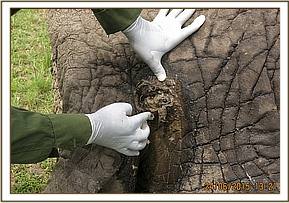

All the necrotic tissue and maggots were removed and the wound debrided with Hydrogen peroxide. The wound was thoroughly lavaged with a copious amount of water before being irrigated with tincture of Iodine. The wounds margins were sprinkled with Ivermectin parasiticide to remove any remaining maggots and finally packed with green clay to absorb toxins and hasten healing. Additional treatments included parenteral administration of 30000mgs Amoxicillin antibiotic, 5000mgs Flunixin meglumine anti-inflammatory and 500mgs Ivermectin parasiticide.
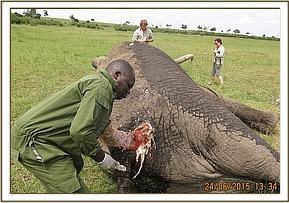

Reversal
Reversal of the anaesthetic was achieved by administration of 48mgs Diprenorphine through a superficial ear vein. He woke up after four minutes without complications.
Prognosis
Hugo is expected to make full recovery.
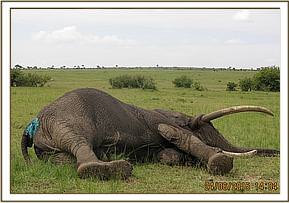

Conclusion
The unit would like to appreciate all the stakeholders who put in their efforts and made it possible for us to attend to these cases. We would also like to thank KWS management for their continuous guidance and help to the unit. Thanks to Minara foundation through The David Sheldrick Wildlife Trust for their continuous facilitation of the unit.
